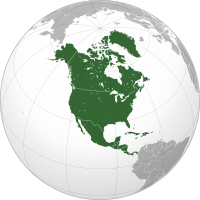
Photo from wikipedia
The leading pattern of boreal spring 250-hPa meridional wind anomalies over the North Atlantic and mid-high latitude Eurasia displays an obvious wave train. The present study documents the structure, energy… Click to show full abstract
The leading pattern of boreal spring 250-hPa meridional wind anomalies over the North Atlantic and mid-high latitude Eurasia displays an obvious wave train. The present study documents the structure, energy source, relation to the North Atlantic sea surface temperature (SST), and impacts on Eurasian climate of this wave train during 1948–2018. This atmospheric wave train has a barotropic vertical structure with five major centers of action lying over subtropics and mid-latitudes of the North Atlantic, northern Europe, central Eurasia, and East Asia, respectively. This spring wave train can efficiently extract available potential energy from the basic mean flow. The baroclinic energy conversion process and positive interaction between synoptic-scale eddies and the mean flow both play important roles in generating and maintaining this wave train. The North Atlantic horseshoe-like (NAH) SST anomaly contributes to the persistence of the wave train via a positive air–sea interaction. Specifically, the NAH SST anomaly induces a Rossby wave-type atmospheric response, which in turn maintains the NAH SST anomaly pattern via modulating surface heat fluxes. This spring atmospheric wave train has significant impacts on Eurasian surface air temperature (SAT) and rainfall. During the positive phase of the wave train, pronounced SAT warming appears over central Eurasia and cooling occurs over west Europe and eastern Eurasia. In addition, above-normal rainfall appears over most parts of Europe and around the Lake Baikal, accompanied by below-normal rainfall to east of the Caspian Sea and over central Asia.
Journal Title: Climate Dynamics
Year Published: 2020
Link to full text (if available)
Share on Social Media: Sign Up to like & get
recommendations!